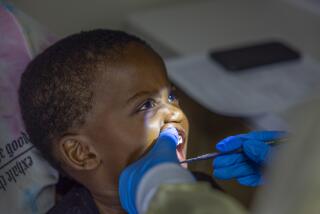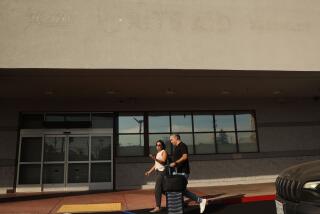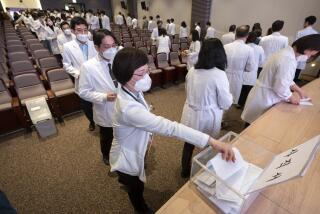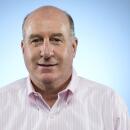Declining Rolls : U.S. Dental Schools Feel the Crunch
- Share via
When classes began this semester, Georgetown University’s 86-year-old dental school had no freshmen. Next year, there will be no sophomores or freshmen. And in 1990, what once was the nation’s largest private dental school will cease to exist.
The Washington university decided earlier this year that the dental school should be phased out, officials say, because of a decline in the number and the quality of applicants, a drop in government aid, escalating tuition and an overcrowded job market for new dentists.
“Faced with these realities, Georgetown University feels that it would be irresponsible to maintain its dental program,” the school announced.
Georgetown’s move triggered a congressional hearing and a lawsuit by angry students and alumni. But the school is not alone.
Sharp Reductions
Two other dental schools--at Emory University in Atlanta and Oral Roberts University in Tulsa, Okla.--made similar decisions over the last three years. And nearly all of the other 57 dental schools nationwide have so sharply curtailed enrollment that experts estimate that the equivalent of 15 dental schools have disappeared since 1975.
“There’s almost a panic in the dental education community,” said William Crawford, dean of USC’s School of Dentistry. “It has created a very demoralized environment.”
The cutbacks have raised questions among some in the profession about dentistry’s future in an era of fluoridation and much less tooth decay.
But others, such as Crawford, view the problem as a temporary reaction to the aging of the baby-boom generation and an end of federal aid. They say dentistry and dental education are not disappearing but are changing emphasis from the traditional “fill and drill” to specialties like cosmetic work and gum treatment; the public wants healthy and attractive teeth more than ever and increasingly has insurance coverage to pay for that, the optimists contend.
Different Tasks
“There will be different tasks for a dentist in the future. We don’t know whether it will require the same number of dentists we have today, fewer or more,” said Richard Mumma, executive director of the American Assn. of Dental Schools. “But it would be irresponsible for us at this point to recommend that more schools close.”
However, statistics about dental schools from his group and other sources are not encouraging.
The number of people who apply each year for admission to dental schools has dropped by about two-thirds since 1975, from 15,734 to about 5,700. This fall’s enrollment of first-year students is about 4,350 nationwide, 30% below the peak of 1978, though near the level during the middle 1960s.
Applicants’ scores on the Dental Aptitude Test and undergraduate science grades have dropped 11% since 1978, and the dropout rate in dental school has doubled. And all that would have been worse without the dramatic increase in the number of women and some minorities, particularly Asians, entering the schools.
California has five dental schools: at USC, UCLA, the University of California, San Francisco, Loma Linda University and the University of the Pacific. None is in danger of closing, officials say, although there have been cutbacks and more are planned.
For example, at UCLA, where tuition for state residents is usually $1,316 a year, 92 first-year students enrolled this year, 16 fewer than the peak in the 1970s. At USC, where tuition is $17,000 a year, freshman enrollment remains at 120 although the school is considering cutting the class size to about 80 over the next decade. The number of yearly applicants to both UCLA and USC dropped by about two-thirds since 1976.
“Our major concern with the falling number of applicants is that it is a signal that dentistry, for whatever reasons, is not seen as being as attractive as it once was,” Mumma said. “We obviously feel it is still a fine profession.”
What happened?
The federal government gave dental schools a total of $786 million through a variety of programs in the late 1960s and early ‘70s because of a perceived national shortage of dentists. Some of that aid was based on a head count of students, giving schools an incentive to boost enrollments. But the grants ended as the need for more dentists was filled and schools were left with huge costs if they did not cut back.
Other Disciplines Chosen
Meanwhile, tuition soared (Georgetown, for example, charges $15,000 a year) and some students entered other less costly and time-consuming graduate schools, such as business administration and engineering, and avoided the further costs involved in starting a dental practice.
The number of applications to medical and law schools also shrank at the end of the baby boom. But dental schools suffered much more, observers say, because dentists in some cities began to complain about too much competition and not enough work.
At local dental association meetings, members reportedly cheered the announcements of school cutbacks. That may have hurt the informal recruiting process in which a young person decides to enter a profession based on favorable impressions of an older role model.
Older dentists complain that the last decade has brought unwelcome trends: complications in patients’ insurance coverage, the jump in the cost of malpractice insurance, the need to wear gloves and masks to prevent the spread of acquired immune deficiency syndrome, the attempt by younger general practice dentists to keep specialty work for themselves, an increase in group clinics that threaten independent practices, and moves by dental hygienists to perform more tasks without dentists’ supervision.
“Dentistry is not as much fun as it used to be,” said a root canal specialist whose long-established practice in the South Bay saw business drop by more than 10% over the last five years. “I don’t see the future of dentistry as good as it was when I got out of school. But, then, maybe I’m just tired.”
In response to declining enrollment, the American Dental Assn. and dental schools last year began a program to recruit applicants. “We are trying to improve the image of dentistry,” said Dick Lewis, a Long Beach dentist who is one of the leaders of the national effort called Select. “We want to spread a little bit of enthusiasm.”
Fighting the Image
Recruiters try to fight the image among some young people that dentistry is monotonous, confining and draining. They boast about the prestige and flexibility of dental work as well as its financial rewards.
According to the most current statistics available from the American Dental Assn., dentists’ net income in 1985 averaged about $70,000, compared to about $113,000 for physicians. Although many dentists in big cities like Los Angeles and many specialists earn several times the national average, some experts say that competition has kept incomes from going higher.
Paul Schoenbaum, student body president at USC’s School of Dentistry, said his classmates realize that some areas of the country have too many dentists so they are willing to join or set up practices in growing, outlying communities such as in Ventura and San Bernardino counties. Also, he said, they know that extra personal service is more important these days.
“Dentists used to be able to just hang a shingle and get work. Now they have to market themselves,” said Schoenbaum, who plans to join a practice in Valencia with his brother.
“There is a lot of competition,” said Steve Cohen, who is the son of a Massachusetts dentist and is one of four students who transferred to USC this fall from what will be the last class at Georgetown. “But if you really want to work and are good at what you do, you’ll always be busy.”
Gordon Lau, who graduated from UCLA’s dental school in 1982 and has had his own practice in Glendale for four years, agreed. “There is work out there to be done. It’s just not as easily available as it was in the past because there are more dentists now. You have to treat your patients right, and people will come.”
In fact, some dentists welcome the cutbacks in school enrollment in hopes that reduced competition will improve the profession’s economic picture in coming years. “Ten or 15 years from now, things will be just fine,” said Costa Mesa dentist Jerry McClellan.
Educators also say it is unfair to compare current enrollment statistics with those of the previous boom. “The middle ‘70s were kind of an anomaly,” said John Yagiela, an associate dean at UCLA’s School of Dentistry. But that, he said, does not totally ease concern about the future.
Rumors persist about the potential closings of more privately run schools. And even four state-run dental schools, at the universities of Mississippi, Colorado, Minnesota and Oklahoma, survived proposed shutdowns after bruising political battles.
“The need for general dentists is not what it used to be. There is a perception of overabundance and the university decided it would be better to spend money for a program that would be on the cutting edge of training and research,” said Steven Budnick, an associate dean at Emory’s School of Dentistry, which will close at the end of the school year except for some postgraduate and research courses.
The Georgetown move was especially unsettling because that school was considered so prestigious. In a pending case in the District of Columbia Superior Court, a group of teachers and students sued the school, seeking to reverse the decision to close.
And in July, the House of Representatives subcommittee that handles education matters in the District of Columbia--chaired by Rep. Mervyn M. Dymally (D-Compton)--held a hearing about how the proposed 1990 closing of the school’s clinic will affect the patients who receive low-cost care there. The clinic had 200,000 patient visits last year and is the busiest in the nation.
“The school owes the city a great deal more consideration than this decision allows,” said Donn Davis, senior legal counsel for the District of Columbia Committee. A spokeswoman for Georgetown said the school has not changed its mind, despite testimony from the American Dental Assn. and others that challenged much of Georgetown’s reasoning. Those experts said the school should only have cut its size; they allege that the university made a decision based on its own financial fears and is trying to justify that with claims about students and the profession.
All dental schools have clinics where students get to practice their profession and patients receive care at prices often half what they would pay elsewhere. Since many of the dental schools are located in or near inner-city neighborhoods, their closure could have devastating effects on the dental health of poor urban families, health officials contend.
As a whole, the dental health of the nation has improved dramatically in a generation, according to federal government studies. That may mean that more people can afford dental care and that dentists are doing a better job. But it also may mean that there will be less of a need for traditional dentistry in the future. That debate is important for the fate of dental schools.
Third Less Decay
A 1980 survey showed that the amount of tooth decay among children and teen-agers--many of whom were in the first generation to grow up drinking fluoridated water--is about a third less than that among the same age group in the early ‘70s. More remarkably, the study said 37% of all youngsters and teen-agers had experienced no tooth decay at all; a decade before, about 25% of them had no decay.
The National Institute of Dental Research also found that older people are keeping more of their natural teeth much later into life than the previous generation, thus eliminating much dental work on false teeth. In 1985, adults between the ages of 18 and 64 each had an average of 25 of their natural teeth, eight more than the same age group had in 1962. Only 13% of Americans between 55 and 64 had none of their natural teeth, compared to 33% of them in 1962, a survey found.
On the other hand, retaining natural teeth, experts say, may require more frequent dental examinations and much more work on gums and root canals. “We are looking at a time, not that far off, when nobody has to lose a tooth to disease,” said Janet Brunelle, an epidemiologist at the National Institute of Dental Research. That will bring change, she said. “Dentistry used to be more of trade; now it is more of a science.”
More and more companies are offering better insurance coverage to employees for the more-complicated and expensive dental work, optimists stress. Plus, some dentists argue that the trend toward a service-oriented economy helps; a computer salesman has to worry more about his looks than his steelworker father had to. Southern California, with its show business industry and obsession with healthy appearances, is thought to be a good market for the bonding, capping and bleaching of cosmetic dentistry.
There were 46.5 dentists for every 100,000 Americans in 1965, and that grew to nearly 59 dentists for every 100,000 citizens last year, according to Richard Weaver, chief of the dental health branch of the U.S. Bureau of Health Professions. The ratio is expected to peak at about 60 dentists in 1990 and then drop to 54.6 by the year 2010, he said.
Concern for Shortage
A healthy ratio is about 57 or 58 dentists per 100,000, Weaver stated. He said he wonders about another shortage of dentists in 25 years.
“If the drop continues, we will be down to about 52 dentists per 100,00,” he said, “and that is just about the area where the government decided in the late ‘60s to intervene to stimulate the number of students going to dental school. However, that may not be the case because the underlying demand for dental services may have dropped.”
The closings of the schools eliminate a flexible response to future needs, Weaver added. “If you keep the schools open, you can always contract the number of students or expand,” he said.
The schools are getting smaller, but the motivation of dental students appears as strong as ever. For example, Corbin Kinser of Modesto decided that the quality of his education at Georgetown would drop as the school phased out. So he and three friends managed to transfer to USC. Three of them packed up their belonging in an 18-foot truck and drove cross-country, towing a car.
A different semester schedule meant they had no time to earn money at summer jobs and moving costs put an additional dent in their personal budgets. “It was hectic. That’s a mild term for what was going on,” said Kinser, now a sophomore.
Kinser dates his interest in dentistry to his boyhood days at the hotel his parents owned at Lake Tahoe. One of their regular guests, he recalled, was a dentist who was also a skillful woodcarver. The combination of skills fascinated Kinser and made him realize the craftsmanship required in dentistry. “I like to work with my hands, on things I can touch and change,” he said. Along with the chance to work independently and help other people, that convinced him to enter the field.
Is he scared about its future? “Not in the least,” he replied. “If other people are scared away, that could actually benefit me and my classmates. But I think this is just a cycle. In five or 10 years, they may increase these schools again.”
More to Read
Sign up for Essential California
The most important California stories and recommendations in your inbox every morning.
You may occasionally receive promotional content from the Los Angeles Times.











